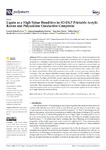Mostrar o rexistro simple do ítem
Lignin as a high-value bioaditive in 3D-DLP printable acrylic resins and polyaniline conductive composite
| dc.contributor.author | Arias-Ferreiro, Goretti | |
| dc.contributor.author | Lasagabáster-Latorre, Aurora | |
| dc.contributor.author | Ares-Pernas, Ana | |
| dc.contributor.author | Ligero, Pablo | |
| dc.contributor.author | García-Garabal, Sandra | |
| dc.contributor.author | Dopico, Sonia | |
| dc.contributor.author | Abad, María-José | |
| dc.date.accessioned | 2023-01-02T10:13:29Z | |
| dc.date.available | 2023-01-02T10:13:29Z | |
| dc.date.issued | 2022-10-04 | |
| dc.identifier.citation | Arias-Ferreiro, G.; Lasagabáster-Latorre, A.; Ares-Pernas, A.; Ligero, P.; García-Garabal, S.M.; Dopico-García, M.S.; Abad, M.-J. Lignin as a High-Value Bioaditive in 3D-DLP Printable Acrylic Resins and Polyaniline Conductive Composite. Polymers 2022, 14, 4164. https://doi.org/10.3390/polym14194164 | es_ES |
| dc.identifier.issn | 2073-4360 | |
| dc.identifier.uri | http://hdl.handle.net/2183/32274 | |
| dc.description.abstract | [Abstract]: With increasing environmental awareness, lignin will play a key role in the transition from the traditional materials industry towards sustainability and Industry 4.0, boosting the development of functional eco-friendly composites for future electronic devices. In this work, a detailed study of the effect of unmodified lignin on 3D printed light-curable acrylic composites was performed up to 4 wt.%. Lignin ratios below 3 wt.% could be easily and reproducibly printed on a digital light processing (DLP) printer, maintaining the flexibility and thermal stability of the pristine resin. These low lignin contents lead to 3D printed composites with smoother surfaces, improved hardness (Shore A increase ~5%), and higher wettability (contact angles decrease ~19.5%). Finally, 1 wt.% lignin was added into 3D printed acrylic resins containing 5 wt.% p-toluensulfonic doped polyaniline (pTSA-PANI). The lignin/pTSA-PANI/acrylic composite showed a clear improvement in the dispersion of the conductive filler, reducing the average surface roughness (Ra) by 61% and increasing the electrical conductivity by an order of magnitude (up to 10-6 S cm-1) compared to lignin free PANI composites. Thus, incorporating organosolv lignin from wood industry wastes as raw material into 3D printed photocurable resins represents a simple, low-cost potential application for the design of novel high-valued, bio-based products. | es_ES |
| dc.description.sponsorship | Xunta de Galicia ; ED481A-2019/001 | es_ES |
| dc.description.sponsorship | Ministerio de Ciencia e Innovación ; PID2020-116976RB-I00 | es_ES |
| dc.description.sponsorship | Xunta de Galicia ; ED431C 2019/17 | es_ES |
| dc.description.sponsorship | Xunta de Galicia ; ED431B 2019/44 | es_ES |
| dc.language.iso | eng | es_ES |
| dc.publisher | MDPI | es_ES |
| dc.relation.uri | https://doi.org/10.3390/polym14194 | es_ES |
| dc.rights | Attribution 4.0 International (CC BY 4.0) | es_ES |
| dc.rights.uri | http://creativecommons.org/licenses/by/3.0/es/ | * |
| dc.subject | Lignin | es_ES |
| dc.subject | DLP | es_ES |
| dc.subject | Polyaniline | es_ES |
| dc.subject | Filler dispersibility | es_ES |
| dc.subject | Additive manufacturing | es_ES |
| dc.subject | Acrylic resin | es_ES |
| dc.title | Lignin as a high-value bioaditive in 3D-DLP printable acrylic resins and polyaniline conductive composite | es_ES |
| dc.type | info:eu-repo/semantics/article | es_ES |
| dc.rights.access | info:eu-repo/semantics/openAccess | es_ES |
| UDC.journalTitle | Polymers | es_ES |
| UDC.volume | 14 | es_ES |
| UDC.issue | 19 | es_ES |
| dc.identifier.doi | https://doi.org/10.3390/polym14194 |
Ficheiros no ítem
Este ítem aparece na(s) seguinte(s) colección(s)
-
GI-Polímeros - Artigos [26]
-
GI-Mesturas - Artigos [23]
-
GI-EnQA-Artigos [16]






